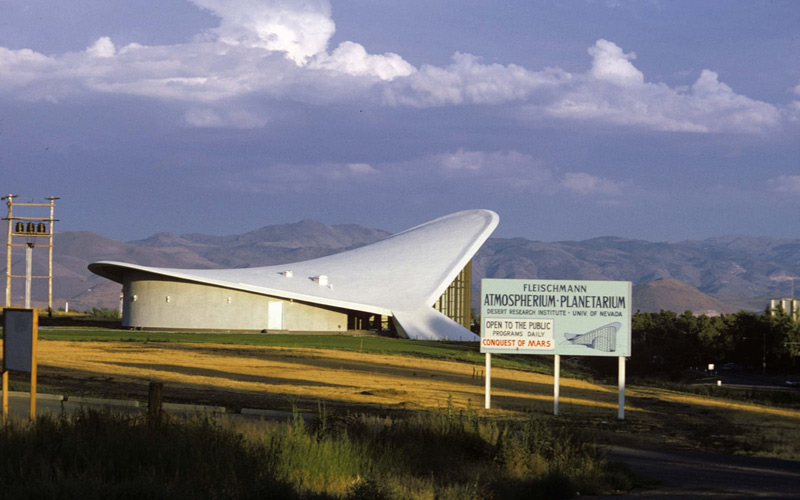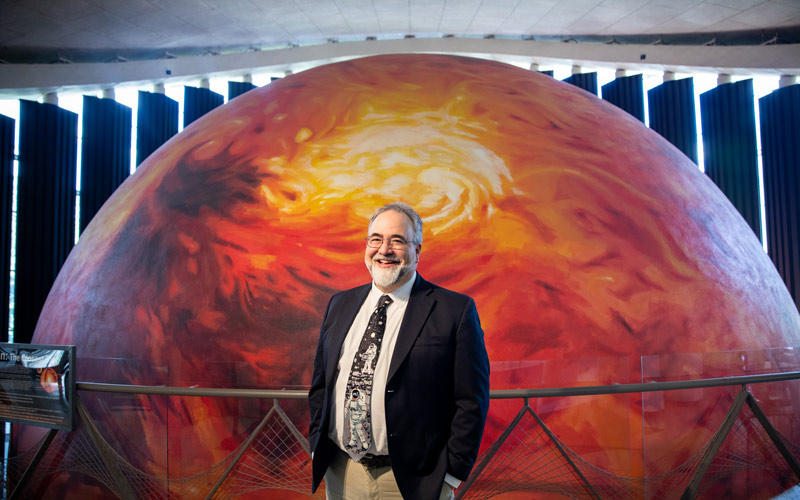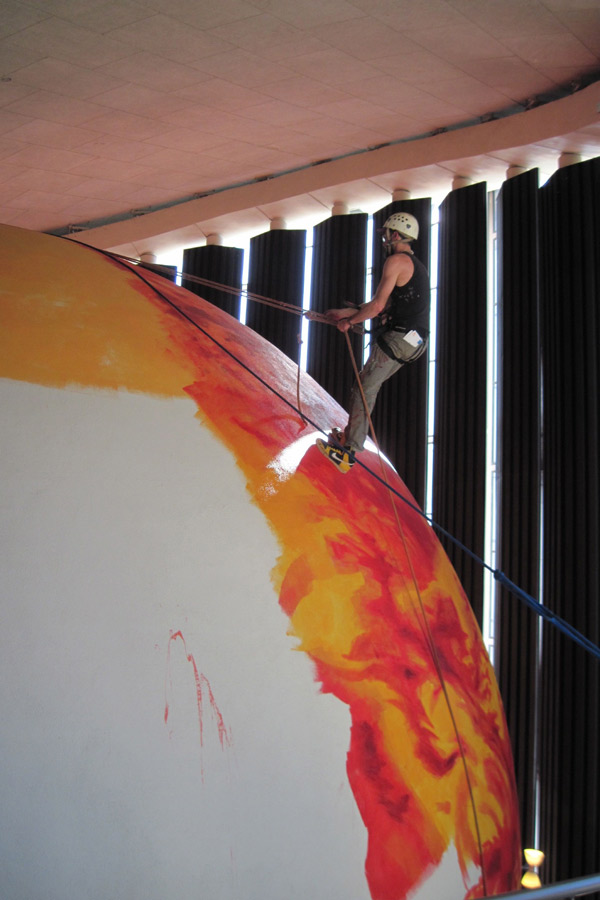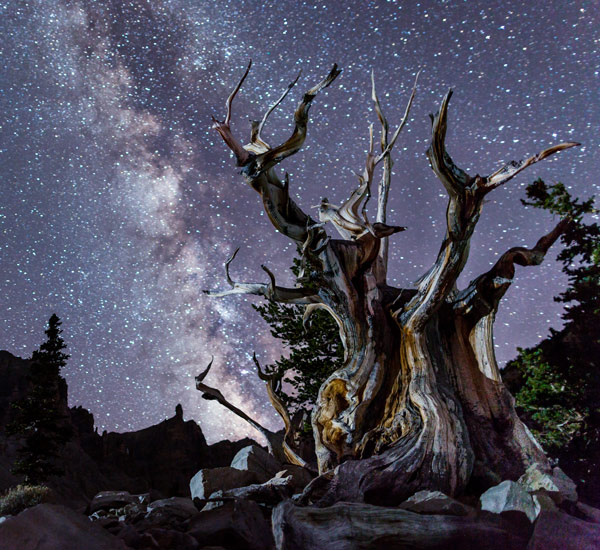Like a giant Pringles potato chip balanced delicately atop floor to ceiling windows reflecting the surrounding trees and sky, the Fleishmann Planetarium and Science Center inspires wonder before visitors even walk through the doors. The iconic Reno building sits at the north end of campus and has been inviting community members to explore the Universe since 1963. More recently, the Planetarium has found a new home in the College of Science.
“We know how important it is to communicate science to the community at large,” Paul McFarlane, Director of the Fleischmann Planetarium, said. “Whether you’re a scientist or not, you still need to know about physics, about space and the world around you. These things impact every aspect of our lives. The Planetarium is a wonderful gateway to the College of Science and the entire University—many of the students taking classes right now came to the Planetarium as a kid. If we can inspire future scientists by bringing them here and exposing them to a world of discovery, that’s a wonderful thing.”
This organizational shift will bring the Planetarium into the College of Science Museum Complex along with the W.M. Keck Earth Science and Mineral Engineering Museum and the Museum of Natural History.
A long history of wonder
For 58 years, the Planetarium has been close to the hearts of Reno locals. Listed on the National Register of Historic Places in 1993, the building and what it holds inside was the ambitious dream of the Planetarium founder and atmospheric physicist Wendell Mordy. The 1960s were marked by a newfound fascination with space and space exploration. As the Soviet Union and the United States raced one another into space, “The Jetsons” and “Star Trek” filled television screens—and planetariums began to pop up across the country. Mordy had grand plans for Nevada’s first planetarium, grander than budgets could support at the time. He approached the Fleishmann Foundation with his intentions for not only building the first planetarium in Nevada, but also the first planetarium in the country to pioneer a new technology he’d helped develop—a 360-degree projector able to display horizon-to-horizon visuals in a dome theater. As an atmospheric physicist, Mordy dreamed of sharing exquisite time lapses of not only the night sky, but of the daytime sky, weather, even under-ocean scenes. And his aspirations didn’t end with what would be built inside the Planetarium. Inspired by the space-age architecture and designs of the time, Mordy worked with Reno architect Raymond Hellman to develop the plan for the building’s unique hyperbolic paraboloid shape. The design was such an extraordinary idea that many people didn’t believe it would work.

“The architect and the engineer, they’d done all the math,” McFarlane said. “They’d worked everything out thoroughly and were very confident about the design of the structure, but other engineers in town didn’t believe it was going to work. A crowd of engineers gathered up here when it was nothing but fields and meadows to watch the 180-ton concrete pour, convinced it was all going to collapse! Well, when they removed the props, it stood brilliantly. And here we are, almost 60 years later, it’s still standing the test of time. The structure is sound, the math is solid and the building continues to soar into space and explore the Universe. This is our spaceship for exploring the wonders of astronomy.”
With funding secured and Mordy’s complete dream realized, the Planetarium was born under its original name—the Fleishmann Atmospherium-Planetarium. It was Nevada’s only planetarium for 14 years and for ten years was the only planetarium in the U.S. utilizing 360-degree projection technology.
“This was the only place where you could have that immersive experience,” McFarlane said. “It began right here in the Biggest Little City in the World. I think it’s exciting that such a distinction, that legacy can be traced to this historic building.”
“Many of us came as kids, and now we bring our own kids, maybe our grandkids, here to the Planetarium.”
Since its inception, the Planetarium has welcomed anywhere between 20,000 and 60,000 guests each year, including around 10,000 students annually on school field trips. Generations of families have toured the gallery, landed a (simulated) spaceship on the Moon, and sat in awe as the Milky Way spread out over the dome theater’s walls.
“Many of us came as kids,” McFarlane said. “And now we bring our own kids, maybe our grandkids, here to the Planetarium.”
The community’s love of the Planetarium twice saved it from closure. As the government shifted focus from space exploration and NASA’s funding waned, the Planetarium, then managed by the Desert Research Institute, also struggled to hold onto funding. In September of 1976, maintenance costs became unsustainable and the Planetarium was forced to close its doors. However, the community jumped into action to save the iconic landmark and community center. The “Save the Stars” fund drive chaired by Clark J. Guild raised $350,000 which was matched by an additional grant of $450,000 from the Fleischmann Foundation and the building was repaired and reopened just a couple of months later. In December of 2002, the community once again defended the Planetarium as plans for the West Stadium Parking Garage threatened the building with demolition. With strong community support over the years, the Planetarium has persevered.
Looking toward the stars
While much about the Planetarium has remained true to its retro space-age origins (the building still looks like it could take off at warp speed at any moment with Captain Kirk at the helm), McFarlane has reinvigorated the Planetarium’s mission and commitment to outreach since starting as director in 2018. A 1990 alumnus of the University, McFarlane studied English, journalism and secondary education as well as astronomy and astrophysics, which he taught K-12 students in the Washoe County School District for more than 25 years. Forever a fan of science fiction, particularly sci-fi that happens in space, McFarlane believes in the power of imagination to inspire a love of learning. As a teacher, he often incorporated stories of space exploration and otherworldly adventures into his classes. Prior to taking the keys to the Planetarium, McFarlane founded the Challenger Learning Center of Northern Nevada where K-12 students are invited to fly a simulated NASA-based mission to space. When the position to direct the Planetarium opened up, McFarlane believed it to be kismet.
“I’d like to think that in some ways your whole life is preparing you for the adventures that you’re meant to undertake,” McFarlane said. “I came here as a kid and I’ve always loved space. If you’d told me as a kid that one day I’d get to work here, I never would have believed you. I love that I’m able to come back and help other young people experience that passion and that adventure that I got to experience as a young person. For me, it’s a dream job.”

McFarlane brought with him exciting new initiatives as well as a variety of new full-dome movies, including the U.S. premier of “Whale Super Highway,” a breathtaking film that follows the migration of whales through the ocean. In 2020, McFarlane made a graceful pivot to virtual astronomy experiences while the Planetarium was closed in response to the COVID-19 pandemic.
“We were the very first planetarium in the world to partner with a group called Slooh to offer remote access to their telescopes,” McFarlane said. “They have these incredible telescopes located in a UNESCO world heritage site high on top of mountains in the Canary Islands, above a lot of the atmosphere and away from light pollution—one of the best places on Planet Earth to explore the Universe. From the comfort of your couch at home you can have the Universe at your fingertips on a smartphone, a tablet or computer.”

With remote access to these telescopes as a Fleischmann Star Walker Space Club member, adults and students from middle through high school are invited to take images for pure pleasure or to perform citizen science experiments looking at double stars, for example, to gather data and potentially have that data published.
Another exciting venture McFarlane brought with him to the Planetarium is the Sci-On! Film Festival. In its 7th year, the festival received several hundred science and science-fiction film submissions from over 46 countries, many of which have received accolades from other international film festivals. In partnership with the National Automobile Museum, the Challenger Learning Center and others, the festival has become uniquely successful in showcasing outstanding science and science-fiction films and filmmakers.
As the Planetarium makes a slow return to more normal operations, McFarlane continues to dream up plans for the future, from ideas for live music events to new displays tying pop-culture to space science. In June, the Planetarium launched a series of themed exhibits and full-dome shows updated each month. Upcoming themes include “The Final Frontier,” “Science and Super Heroes” and more. One of McFarlane’s long-term goals is to make a significant upgrade to the full-dome theater system, once again putting Nevada’s space place at the forefront of planetariums worldwide.
“We have a lot on the horizon, and we continue to dream big,” McFarlane said. “We’re continuing to reach for the stars, which is really what our organization is all about.”
Imagination meets education
Since its inception, the Planetarium has had deep ties to science education in Nevada and to the University. With the Planetarium now fittingly incorporated into the College of Science, those connections will only be strengthened. The Department of Physics, Department of Geological Sciences and Engineering, and the accompanying astrophysics, astronomy and atmospheric sciences programs all have unique and long histories of engagement with the Planetarium. The future of collaborative research and outreach opportunities is bright.
“The Planetarium offers opportunities to explore the known and the unknown,” Paul Neill, the Clemons-Magee Endowed Professor in Physics and Department of Physics Chair, said. “It is hard to imagine anyone looking up at a clear night sky and not being inspired by what they see. The planetarium, and astronomy and astrophysics programs, are almost literally the window to pushing imaginations to their limit. The department looks forward to many years of collaboration with the Planetarium staff to explore new ways to excite the next generation of scientists.”
Projects that have already taken off include both the Department of Physics and the Planetarium’s engagement with the Great Basin Observatory, the first research-grade observatory in a U.S. National Park. The Planetarium screened a short 4-minute film they made in partnership with the Great Basin Observatory called “Explore the Universe” at this year’s Sci-On! Film Festival, and Neill believes the Department of Physics membership in the Great Basin Observatory Cooperative opens the door to even more opportunities for education, outreach and research.
“Our hope is that we can offer the Planetarium access to the Great Basin Observatory in ways that will enhance outreach experiences with the local community and, in particular, with K-12 students,” Neill said. “Astronomy is often considered a ‘gateway science’ and the goal of these outreach activities is to get diverse groups and communities excited about astronomy, astrophysics and science in general.”

Faculty are also excited about the potential of partnering with the Planetarium and using the space as a resource for enhancing both classes and research.
“Some parts of astronomy are nearly impossible to teach in a traditional classroom but are a breeze in a planetarium,” Assistant Professor of Physics and Astronomy Richard Plotkin said. “By projecting the night sky in the Planetarium’s dome, we can do things like fast forward time to show how the phases of the moon work or show why the night sky looks different in winter versus summer. We can teach students how to locate stars in the sky in a controlled environment during the day, before attempting to take observations with telescopes at night.
“I envision opportunities for researchers across the College of Science to collaborate with the Planetarium, especially because of the Planetarium’s ability to project high-resolution images and videos onto their dome. As digital projections continue to improve, the Planetarium could become a resource to help those working with big datasets visualize and examine their data in nontraditional ways.”
From Professor and Department of Geological Sciences and Engineering Chair Wendy Calvin working on the Mars Exploration Rover Team and alumna Julie Robinson serving as Chief Scientist for Human Exploration and Operations at NASA, the College of Science is no stranger to the adventure of space exploration. In joining forces with the Planetarium, the College looks forward to helping bring that adventure to the community. With generations of families having already been inspired by the giant spaceship at the north end of campus, McFarlane is devoted to doing the same.
“Our mission at the Planetarium is to engage, educate and explore,” McFarlane said. “We get to engage people with the adventure of space and stars and planets. We get to explore the Universe. And in the process, we get to educate ourselves about our place in space and time. If we have a better understanding of the world in which we live, maybe we can make better decisions as citizens of a democracy. I hope the Planetarium, especially now as part of the College of Science, can help all of our citizens become more scientifically informed, scientifically literate, and continue this great enterprise of discovery for ourselves and for our kids and future generations.”















